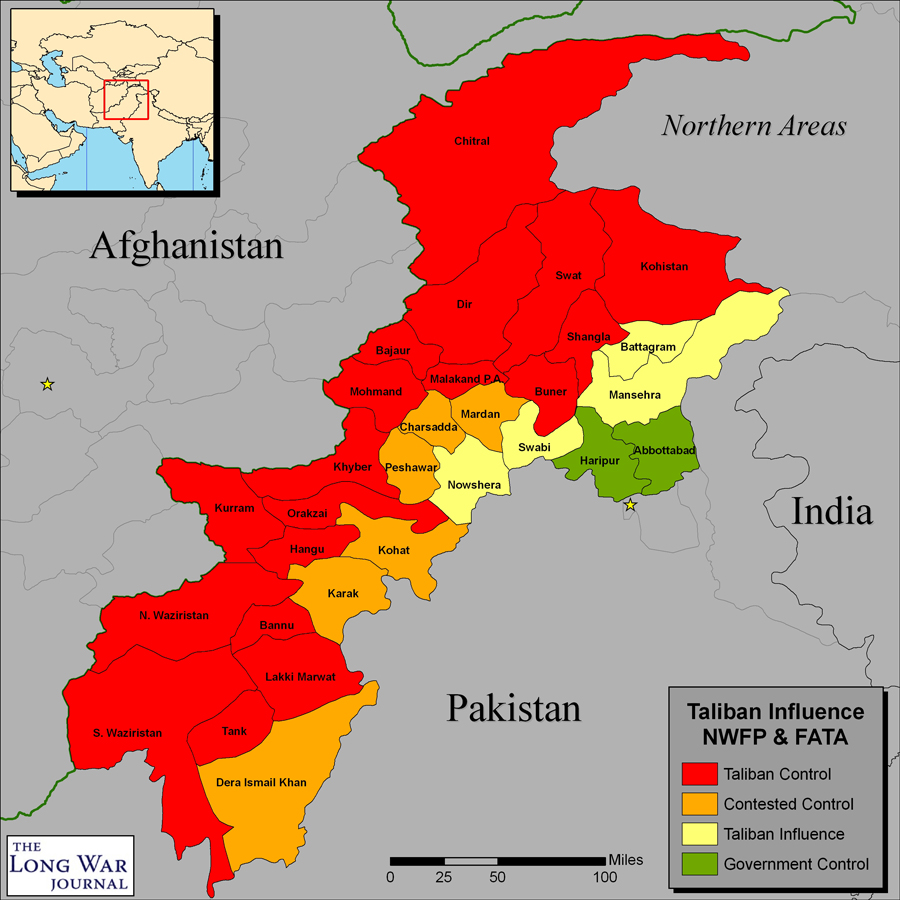April 14, 2009

Click map for full view. Taliban presence, by district and tribal agency, in the Northwest Frontier Province and the Federally Administered Tribal Agencies. Information on Taliban presence obtained from open source and derived by The Long War Journal based on the presence of Taliban shadow governments, levels of fighting, and reports from the region. Map created by Bill Raymond for The Long War Journal.
The Pakistani government's peace agreement with the Swat Taliban and the subsequent approval of the sharia regulation have bolstered Islamist terrorists in northwestern Pakistan and created a new safe haven for al Qaeda and other terrorist groups.
The peace agreement, known as the Malakand Accord, was implemented in the Malakand Division in mid-February. It has provided a victory for the Taliban. The agreement calls for the withdrawal of the Pakistani Army from Swat, the release all Taliban prisoners, the withdrawal of any criminal cases against Taliban leaders and fighters, and the imposition of sharia. The Malakand Division is an administrative region that encompasses more than one-third of the Northwest Frontier Province and includes the districts of Malakand, Swat, Shangla, Buner, Dir, Chitral, and Kohistan.
President Asif Ali Zardari, the leader of the secular Pakistani Peoples Party, signed the sharia bill into law yesterday following the military's failure to restore the government’s writ in Swat after three attempts since 2007. Zardari previously had said he would not sign the bill until peace was restored to Swat, but he relented in the face of political pressure, Taliban threats, and a lightning Taliban advance into Buner.
Since the signing of the Malakand Accord, the number of Taliban fighters has increased dramatically in Swat, The Wall Street Journal reported. Previously estimated at 2,000 to 4,000, the number of Taliban fighters there is now said to have skyrocketed to somewhere between 6,000 and 8,000.
"Militant training camps are springing up across the valley's thickly forested mountainsides," the WSJ reported, and are being filled with recruits, some who feel coerced to join. "Residents said many young men are joining the militants to ensure the safety of their families, who they hope will be left in peace if one of their own is fighting the government."
The signing of the Malakand Accord put the Taliban in position to double its recruiting and taxation base [see LWJ report, Analysis: Pakistan peace agreement cedes ground to the Taliban]. The Malakand Division has a population of more that 4.3 million, according to the 1998 census. The Taliban effectively control the tribal areas (population estimated at 6.5 million in 1998) and many of the bordering districts with millions more. The Taliban recently took control of the lucrative emerald mines in Swat and neighboring Shangla and are using the profits to fund operations.
Al Qaeda and other Islamist terror groups are known to operate in Swat. The largest contingent, the Tora Bora Group, is led by a brutal and efficient al Qaeda commander known as Ibn Amin.
"The faction consists of foreign fighters and local militants trained by Al Qaeda operatives, who operated in the Afghan region of Tora Bora where Osama bin Laden dodged US forces in early 2002 before going underground," Deutsche Presse Agentur reported.
The Tora Bora Group is estimated to have more than 1,000 fighters operating in Swat, intelligence officials told DPA. Amin is known to run an al Qaeda training camp in the village of Peuchar.
Amin's forces are said to have led the vanguard of Taliban fighters who invaded the neighboring district of Buner. The Taliban took over Buner in just six short days after brief clashes with police and tribal militias that were formed to oppose the extremists' entry. Buner is just miles from the capital of Islamabad.
After the Taliban conquest of Buner, Taliban forces openly paraded through several districts in northwest Pakistan. A Taliban convoy of 10 trucks filled with fighters brandishing heavy weapons drove from Buner, through the district center in Swabi, and through Mardan before passing into Malakand, Dawn reported.
The Taliban convoy was untouched by Pakistani security forces. "They drove through a district HQ of a district they have not yet occupied ... on the federally policed motorway; through an army cantonment – as a matter of fact right past the Punjab Regimental Centre’s shopping plaza containing the usual bakery and pastry-shop run by serving soldiers – and thence through the rest of the crowded city of Mardan which is also the home of the chief minister of the province," Dawn reported.
Amin is the leader of the Shadow Army contingent operating in Swat, a US intelligence official told The Long War Journal. The Shadow Army, or Lashkar al Zil, is al Qaeda's elite paramilitary army that operates in Pakistan and Afghanistan [see LWJ exclusive report, Al Qaeda's paramilitary 'Shadow Army']. The unit has its roots in the 055 Brigade, which fought conventional battles against the Northern Alliance and US forces in Afghanistan, including at Tora Bora.
The Shadow Army is estimated to have between 8,000 to 12,000 fighters in its ranks. It is organized as an army but typically fights at the platoon and company level (between 30 to 100 fighters). Its members may also be assigned as embedded trainers to Taliban forces in Pakistan and Afghanistan.
The new leader of the Shadow Army is Abdullah Sa'id [see LWJ exclusive report, Al Qaeda's Shadow Army commander outlines Afghan strategy]. He succeeded Khalid Habib al Shami, who was killed in a US Predator strike on a compound in North Waziristan in October 2008.








No comments:
Post a Comment